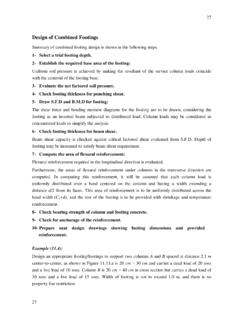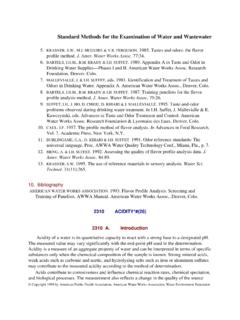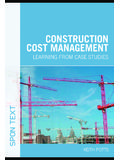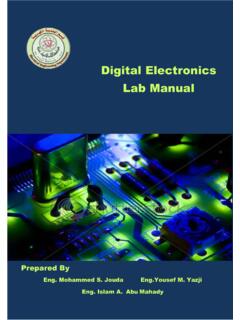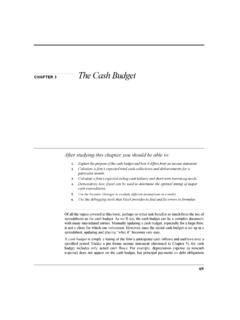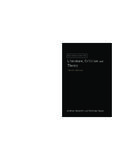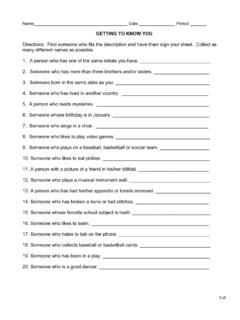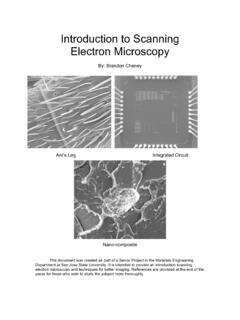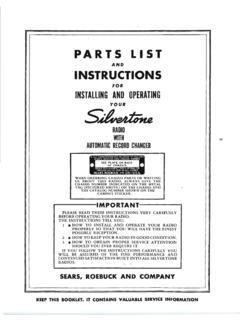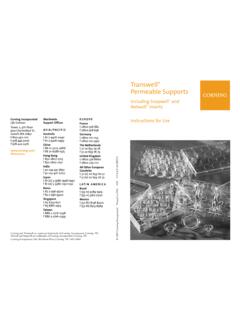Transcription of Design of Columns - Islamic University of Gaza
1 1. Design of Columns Introduction According to ACI Code , a structural element with a ratio of height-to-least lateral dimension exceeding three used primarily to support compressive loads is defined as column. Columns support vertical loads from the floor and roof slabs and transfer these loads to the footings. Columns usually support compressive loads with or without bending. Depending on the magnitude of the bending moment and the axial force, column behavior will vary from pure beam action to pure column action. Columns are classified as short or long depending on their slenderness ratios. Short Columns usually fail when their materials are overstressed and long Columns usually fail due to buckling which produces secondary moments resulting from the P effect. Columns are classified according to the way they are reinforced into tied and spirally reinforced Columns . Columns are usually reinforced with longitudinal and transverse reinforcement.
2 When this transverse reinforcement is in the form of ties, the column is called tied . If the transverse reinforcement is in the form of helical hoops, the column is called spirally reinforced . Since failure of Columns often cause extensive damage, they are designed with a higher factor of safety than beams. Types of Columns Columns are divided into three types according to the way they are reinforced. Tied Columns A tied column, shown in Figure 1, is a column in which the longitudinal reinforcement bars are tied together with separate smaller diameter transverse bars (ties) spaced at some interval along the column height. These ties help to hold the longitudinal reinforcement bars in place during construction and ensure stability of these bars against local buckling. The cross sections of such Columns are usually square, rectangular, or circular in shape. A minimum of four bars is used in rectangular and circular cross sections.
3 2. Figure 1: Tied column Spirally-Reinforced Columns They are Columns in which the longitudinal bars are arranged in a circle surrounded by a closely spaced continuous spiral, shown in Figure 2. These Columns are usually circular or square in shape. A minimum of six bars is used for longitudinal reinforcement. Figure 2: Spirally-reinforced column Composite Columns A composite column is a column made of structural steel shapes or pipes surrounded by or filled by concrete with or without longitudinal reinforcement, shown in Figure 3. 3. Figure 3:Composite column Behavior of Tied and Spirally-Reinforced Columns Axial loading tests have proven that tied and spirally reinforced Columns having the same cross- sectional areas of concrete and steel reinforcement behave in the same manner up to the ultimate load, as shown in Figure At that load tied Columns fail suddenly due to excessive cracking in the concrete section followed by buckling of the longitudinal reinforcement between ties within the failure region, as shown in Figure (a).
4 4. (b). Figure 4: Failure of Columns ; (a) behavior of tied and spirally- reinforced Columns ; (b) failure of Columns For spirally reinforced Columns , once the ultimate load is reached, the concrete shell covering the spiral starts to peel off. Only then, the spiral comes to action by providing a confining force to the concrete core, thus enabling the column to sustain large deformations before final collapse occurs. Factored Loads and Strength Reduction Factors Factored Loads Load factors for dead, live, wind or earthquake live loads combinations are shown in Table 1. Table 1: Required Strength for simplified load combinations Loads Required Strength Equation NO. Dead (D) and Live (L) D ( ). D + L ( ). Dead (D), Live (L) and wind D + L ( ). (W) D + W ( ). D + W + L ( ). D + W ( ). Dead (D), Live (L) and D + L + E ( ). Earthquake (E) D + E ( ). Strength Reduction Factors According to ACI strength reduction factors for compression-controlled sections are given as follows: Members with spiral reinforcement = 5.
5 Other reinforced members = The basic equation is given by Pu Pn (1). where Pu = factored axial load = strength reduction factor Pn = nominal axial load Short Axially Loaded Columns Figure 5: Uniaxial stress-strain curves for steel and concrete When axial compressive loads are applied through the centroid of the cross section of a short column, concrete and steel reinforcement are shortened by the same amount due to their composite action. The ultimate load is attained when the reinforcement reaches its yield stress and the concrete reaches its 28-day compressive strength simultaneously, shown in Figure 5. From equilibrium of forces in the vertical direction, Pno = Pnc + Pns ( 2). or, Pno = f c (Ag As ) + As f y ( 3). Where Pno = nominal axial capacity of section at zero eccentricity Pnc = nominal axial load carried by concrete 6. Pns = nominal axial load carried by steel reinforcement Ag = gross sectional area of column As = cross sectional area of reinforcement f c = concrete compressive strength at 28-days Equation (3) yields larger values than those obtained from laboratory testing due to the better quality of the tested concrete cylinders.
6 Reducing the compressive strength in Equation (3) by 15. % gives results in close agreement with those obtained through testing schemes. Pno = f c (Ag As ) + As f y (4). The above equation is appropriate for determining axial load capacities of already designed Columns . Equation (4) could be modified to suit the process of designing Columns through the following substitution As = g Ag where g is the reinforcement ratio Pno = f c (Ag g Ag ) + g Ag f y Pno = Ag [ fc + g ( f y fc )] (5). To account for accidental eccentricity resulting from misalignment of reinforcement, voids in the concrete section, unbalanced moments in the beam, or misalignment of Columns from one floor to another, ACI Code and reduce the strength of tied Columns by 20 % and spirally reinforced Columns by 15 %. For capacity calculation of tied Columns , the following equation is to be used;. [ ( ) ]. Pu = ( ) f ' c Ag As + As f y , or [ ( ).]
7 Pu = f ' c Ag As + As f y ]] (6). For capacity calculation of spirally reinforced Columns , the following equation is to be used;. Pu = ( )( )[ fc (Ag As ) + As f y ], or [. Pu = fc (Ag As ) + As f y ] (7). For Design purposes of tied and spirally reinforced Columns respectively, [ (. Pu = Ag f ' c + g f y f ' c )] (8). Pu = Ag [ fc + g ( f y fc ) ] (9). 7. Design of Spiral Laboratory tests have proved that compressive strength of the concrete confined within a spiral is increased due to the lateral pressure exerted on the concrete core by the spiral hoops, as shown in Figure 6. (a). (b) (c). Figure 6: (a) Influence of lateral pressure f 2 on the ultimate compressive strength; (b) lateral pressure on core; (c) lateral pressure on spiral The ultimate compressive strength of laterally pressured cylinders is given by f1 = f c + f 2 (10). where f1 = compressive strength of test cylinders in biaxial compression at 28-days.
8 F c = compressive strength of test cylinders in uniaxial compression at 28-days. f 2 = applied horizontal pressure. The spiral is proportioned so that additional compressive strength provided by the confining action of the spiral is equal to the strength provided by the spalled concrete shell covering the spiral when the spiral is stressed to its yield. This is given by f c (Ag Ac ) = f 2 ( Ac ). or, f c (Ag Ac ) f c Ag . f2 = = . ( Ac ) A 1 (11). c . where 8. Ag = column's gross sectional area Ac = area of concrete core based on a diameter measured out-to-out of spiral Consider a concrete cylinder equal in depth to the pitch of the spiral S and neglect the slope of the spiral. Cutting the cylinder vertically along a diameter gives the following equilibrium equation in the horizontal direction as shown in Figure 7. (a) (b). Figure 7: (a) Free body diagram of core and spiral cut-along a diameter.
9 (b) one turn of spiral 2 a s f sy = Dc S f 2. 2 a s f sy f2 = (12). Dc S. where a s = cross-sectional area of spiral f sy = yield stress of spiral Dc = core diameter = diameter minus twice the concrete cover S = spiral's pitch Substituting Equation (12) into Equation (11). (2 a s f sy ). f c (Ag Ac ) = Ac Dc S. fc Ag a f 1 = s sy (13). Ac Dc S. letting s be the ratio of volume of spiral reinforcement in one turn to volume of core inside it , or a s Dc 4 as s = =. ( D c / 4) S Dc S. 2. s Dc S. and a s = (14). 4. 9. Substituting Equation (14) into Equation (13) gives f c Ag s D c S f sy s f sy 1 = =. Ac 4 Dc S 4. or, f c Ag . s = 1 (15). A . f sy c . The constant in the previous equation is replaced by to get the equation given in ACI f c Ag . And s = 1 (16). f sy Ac .. Combining equations (14) and (16), the pitch of the spiral S is given as 4 as S= (17). Ag fc . Dc 1 . f . Ac sy . Columns Subjected To Pure Axial Tension The strength under pure axial tension is computed assuming that the section is completely cracked and subjected to a uniform strain equal to, or less than y.
10 The axial capacity of the concrete is ignored and the axial strength in tension is given by the following equation. Pu = As f y (18). where is the strength reduction factor for axial tension = , and As is the area of column reinforcement. Design Considerations Maximum and Minimum Reinforcement Ratios ACI Code specifies that a minimum reinforcement ratio of 1 % is to be used in tied or spirally reinforced Columns . This minimum reinforcement is needed to safeguard against any bending, reduce the effect of shrinkage and creep and enhance ductility of Columns . Maximum reinforcement ratio is limited to 8 % for Columns in general to avoid honeycombing of concrete. For compression member with a cross section larger than required by consideration of loading, ACI Code permits the minimum area of steel reinforcement to be based on the gross sectional area required by analysis. The reduced sectional area is not to be less than one half the actual cross sectional dimensions.
